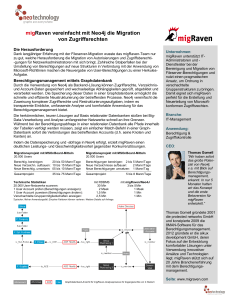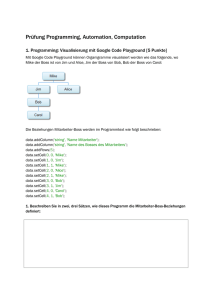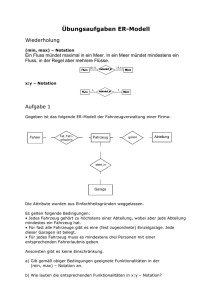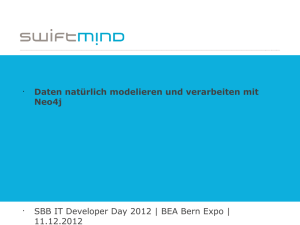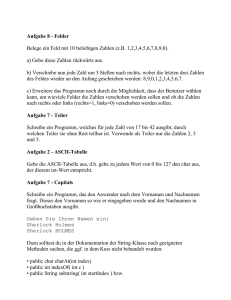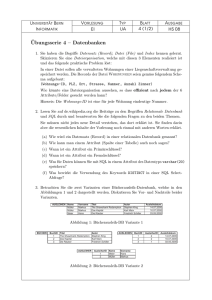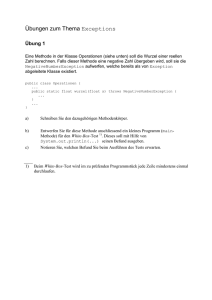Kai - Java Forum Stuttgart 2013
Werbung
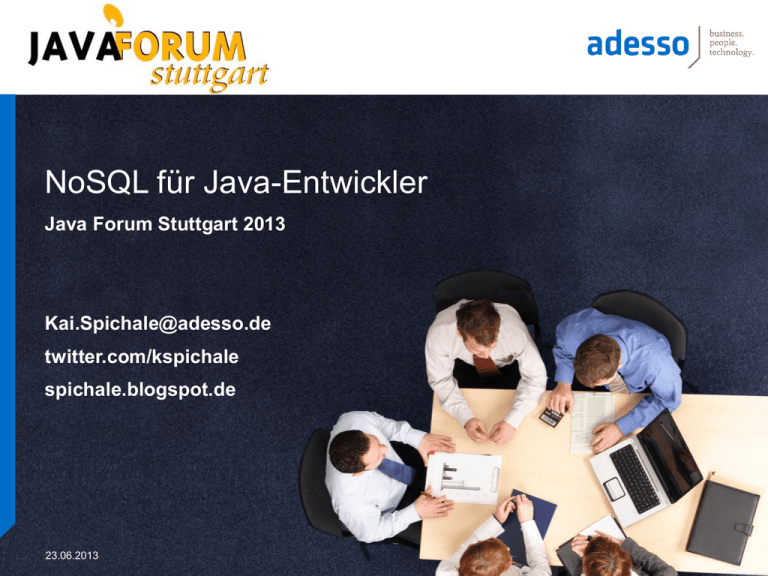
NoSQL für Java-Entwickler Java Forum Stuttgart 2013 [email protected] twitter.com/kspichale spichale.blogspot.de 23.06.2013 Datengröße Agenda Key-value Stores 1. Wide Column Cassandra 2. Document Databases MongoDB 3. Graph Databases Neo4j Datenkomplexität 23.06.2013 1 Apache Cassandra http://cassandra.apache.org/ 2 Apache Cassandra Beschreibung ► Verteilter Wide Column Store ► Kombiniert Features von Amazon Dynamo und Google Big Table ► Apache License 2.0 ► Java Wichtige Features ► Horizontale Skalierung durch Sharding ► Replikation (wählbare Konsistenzstufen) ► High Performance I/O ► Fehlertolerant Kommerzieller Support ► DataStax 23.06.2013 3 Hector Client API Cluster cluster = HFactory.getOrCreateCluster("cluster", "localhost:9160"); Keyspace keyspace = HFactory.createKeyspace("demo", cluster); ColumnFamilyTemplate<String, String> template = new ThriftColumnFamilyTemplate<String, String>( keyspace, "user", StringSerializer.get(), StringSerializer.get()); Stiring id = TimeUUIDUtils.getTimeUUID(new Date().getTime()).toString(); ColumnFamilyUpdater<String, String> updater = template.createUpdater(id); updater.setString(FIRSTNAME, "Kai"); updater.setString(LASTNAME, "Spichale"); template.update(updater); 23.06.2013 4 Hector Client API Eigenschaften: > Clientseitiges Failover > Connection Pooling > Load Balancing > Kapselt Cassandra Thrift API > Einfacher Object Mapper – Keine Unterstützung für CQL 3 Features wie Compound Keys 23.06.2013 5 JDBC Driver für Cassandra Connection con = DriverManager.getConnection( "jdbc:cassandra://102.5.12.121:9160/system?version=3.0.0"); String query = "CREATE TABLE tweet ( user_id varchar, tweet_id varchar, author varchar, message varchar, PRIMARY KEY(user_id,tweet_id) );"; PreparedStatement statement = con.prepareStatement(query); statement.execute(); statement.close(); 23.06.2013 6 Beispiel: Twitter timeline Logische Sicht auf Tabelle timeline user_id tweet_id author message Kai 4811 Bob I love coffee Kai 0815 Paul Thank god it‘s friday Mike 4811 Bob I love coffee CREATE TABLE timeline ( user_id varchar, tweet_id uuid, author varchar, message varchar, PRIMARY KEY (user_id, tweet_id) ); 23.06.2013 7 Beispiel: Twitter timeline Logische Sicht auf Tabelle timeline user_id tweet_id author message Kai 4811 Bob I love coffee Kai 0815 Paul Thank god it‘s friday Mike 4811 Bob I love coffee Physisches Layout mit Composite Columns Kai [4811,author]: Bob [4811, message]: I love coffee Mike [4811,author]: Bob [4811, body]: I love coffee 23.06.2013 8 [0815,author]: Paul [0815,body]: Thank god it‘s friday Kundera: Object Mapping @Entity @Table(name="tweet", schema="demo@cassandra_pu") public class TweetEntity { @EmbeddedId private TweetEntityPK pk; @Column private String author; @Column private String message; // ... } 23.06.2013 9 Kundera: Zusammengesetzter Schlüssel @Embeddable public class TweetEntityPK { @Column(name = "tweet_id") private String tweetId; @Column(name = "user_id") private String userId; // ... } 23.06.2013 10 Kundera: JPA-ähnliche Persistenz EntityManagerFactory emf = Persistence.createEntityManagerFactory("pu"); EntityManager em = emf.createEntityManager(); em.setProperty("cql.version", "3.0.0"); weetEntityPK pk = new TweetEntityPK(); pk.setUserId("42"); pk.setTweetId(UUID.randomUUID().toString()); TweetEntity tweet = new TweetEntity(); tweet.setPk(pk); tweet.setAuthor("Kai"); tweet.setMessage("Java Forum Stuttgart 2013"); em.persist(tweet); 23.06.2013 11 Kundera: JPA-ähnliche Persistenz TweetEntity tweet = em.find(TweetEntity.class, pk); Query q = em.createNativeQuery( "select * from tweet where user_id = '42' limit 10;", TweetEntity.class); List<TweetEntity> list = q.getResultList(); 23.06.2013 12 MongoDB http://www.mongodb.org/ 13 MongoDB Beschreibung ► JSON-Dokumentendatenbank ► GNU AGPL v3.0 ► Implementiert in C++ Wichtige Features ► Horizontale Skalierung durch Sharding ► Master-Slave-Replikation ► Server-seitige JavaScript-Ausführung Entwicklung und kommerzieller Support ► 10gen 23.06.2013 14 Mongo Java Driver MongoClient client = new MongoClient(new ServerAddress("localhost", 27017)); DB database = client.getDB("demo"); DBCollection collection = database.getCollection("events"); BasicDBObject event = new BasicDBObject(); event.append("title", "Java Forum Stuttgart 2013"); event.append("participant_number", 1500); BasicDBObject venue = new BasicDBObject(); venue.append("city", "Stuttgart"); event.append("venue", venue); collection.insert(event); 23.06.2013 15 Mongo Java Driver AggregationOutput output = collection.aggregate( // Group events new BasicDBObject("$group", new BasicDBObject("_id", "$venue.city") .append("count", new BasicDBObject("$sum","$participant_number"))), // Sort grouped elements new BasicDBObject("$sort", new BasicDBObject("count", 1)) ); for (DBObject doc : output.results()) { String city = (String) doc.get("city"); Double count = (Double) doc.get("count"); // ... } 23.06.2013 16 Spring Data Beschreibung ► Entwickelt von VMware / SpringSource ► Apache License v2.0 ► Unterstützung: MongoDB, Neo4j, Redis, Hbase, Apache Hadoop, JPA, … Wichtige Features ► Repository Support > Abfragen abgeleitet von Methodensignaturen ► Object / Document Mapping > Mittels Annotationen wie @Document, @NodeEntity, @Indexed, etc. ► Templating > Konfiguration von Verbindungen > Abstraktion von Ressourcen 23.06.2013 17 Neo4j http://www.neo4j.org/ 18 Neo4j Beschreibung ► Graphenorientierte Datenbank ► AGPLv3 / kommerziell ► Implementiert in Java Wichtige Features ► ACID-Transaktionen ► Traversal Framework für schnelle Graphenabfragen ► Disk-basiert: Spezielles binäres Festplattenformat Entwicklung und kommerzieller Support ► Neo Technology 23.06.2013 19 Neo4j Spring Data: Einen Graphen speichern GraphDatabaseService graphDb = new GraphDatabaseFactory().newEmbeddedDatabase(DB_PATH); Transaction tx = graphDb.beginTx(); try { Node bob = graphDb.createNode(); bob.setProperty("name", "Bob"); Node alex = graphDb.createNode(); alex.setProperty("name", "Alex"); bob.createRelationshipTo(alex, DynamicRelationshipType.withName("FOLLOWS")); tx.success(); } finally { tx.finish(); } 23.06.2013 20 Neo4j Spring Data: Der kürzeste Weg Node bob = indexService.get("name", "Bob").getSingle(); Node alex = indexService.get("name", "Alex").getSingle(); DynamicRelationshipType rel = DynamicRelationshipType.withName("FOLLOWS"); PathFinder<Path> finder = GraphAlgoFactory.shortestPath( Traversal.expanderForTypes(rel, Direction.BOTH), MAX_DEPTH); Path path = finder.findSinglePath(bob, alex); 23.06.2013 21 Neo4j Spring Data: Anzahl verbundener Benutzer TraversalDescription td = Traversal .description() .breadthFirst() .relationships(FOLLOWS, Direction.OUTGOING) .evaluator(Evaluators.excludeStartPosition()) .evaluator(Evaluators.toDepth(DEPTH)); Traverser friendsTraverser = td.traverse(node); int[] counters = new int[DEPTH+1]; for (Path friendPath : friendsTraverser) { counters[friendPath.length()]++; } 23.06.2013 22 Neo4j Spring Data: Object Mapping @NodeEntity public class UserEntity { @GraphId private Long id; @Indexed(indexName = "user_index", indexType = IndexType.FULLTEXT) private String name; @RelatedTo(direction = Direction.OUTGOING, elementClass = UserEntity.class, type = "follower") private Set<UserEntity> follower; // ... } 23.06.2013 23 Neo4j Spring Data: Repositories public interface UserRepository extends GraphRepository<UserEntity> { @Query(value = "start user=node:user_index(name={0}) match user-[:follower]->followingUser return followingUser") Set<UserEntity> findFollower(String name); // ... } 23.06.2013 24 Vielen Dank für Ihre Aufmerksamkeit! [email protected] twitter.com/kspichale spichale.blogspot.de 25
